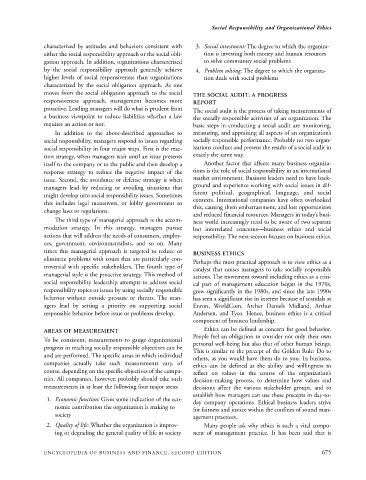Page 698 - Encyclopedia of Business and Finance
P. 698
eobf_S 7/5/06 3:21 PM Page 675
Social Responsibility and Organizational Ethics
characterized by attitudes and behaviors consistent with 3. Social investment: The degree to which the organiza-
either the social responsibility approach or the social obli- tion is investing both money and human resources
gation approach. In addition, organizations characterized to solve community social problems
by the social responsibility approach generally achieve 4. Problem solving: The degree to which the organiza-
higher levels of social responsiveness than organizations tion deals with social problems
characterized by the social obligation approach. As one
moves from the social obligation approach to the social
THE SOCIAL AUDIT: A PROGRESS
responsiveness approach, management becomes more REPORT
proactive. Leading managers will do what is prudent from
The social audit is the process of taking measurements of
a business viewpoint to reduce liabilities whether a law the socially responsible activities of an organization. The
requires an action or not. basic steps in conducting a social audit are monitoring,
In addition to the above-described approaches to measuring, and appraising all aspects of an organization’s
social responsibility, managers respond to issues regarding socially responsible performance. Probably no two organ-
social responsibility in four major ways. First is the reac- izations conduct and present the results of a social audit in
tion strategy, when managers wait until an issue presents exactly the same way.
itself to the company or to the public and then develop a Another factor that affects many business organiza-
response strategy to reduce the negative impact of the tions is the role of social responsibility in an international
issue. Second, the avoidance or defense strategy is when market environment. Business leaders need to have back-
managers lead by reducing or avoiding situations that ground and experience working with social issues in dif-
might develop into social responsibility issues. Sometimes ferent political, geographical, language, and social
contexts. International companies have often overlooked
this includes legal maneuvers, or lobby government to
this, causing them embarrassment, and lost opportunities
change laws or regulations.
and reduced financial resources. Managers in today’s busi-
The third type of managerial approach is the accom- ness world increasingly need to be aware of two separate
modation strategy. In this strategy, managers pursue but interrelated concerns—business ethics and social
actions that will address the needs of consumers, employ- responsibility. The next section focuses on business ethics.
ees, government, environmentalists, and so on. Many
times this managerial approach is targeted to reduce or
BUSINESS ETHICS
eliminate problems with issues that are particularly con-
Perhaps the most practical approach is to view ethics as a
troversial with specific stakeholders. The fourth type of
catalyst that causes managers to take socially responsible
managerial style is the proactive strategy. This method of actions. The movement toward including ethics as a criti-
social responsibility leadership attempts to address social cal part of management education began in the 1970s,
responsibility topics or issues by using socially responsible grew significantly in the 1980s, and since the late 1990s
behavior without outside pressure or threats. The man- has seen a significant rise in interest because of scandals at
agers lead by setting a priority on supporting social Enron, WorldCom, Archer Daniels Midland, Arthur
responsible behavior before issue or problems develop. Andersen, and Tyco. Hence, business ethics is a critical
component of business leadership.
AREAS OF MEASUREMENT Ethics can be defined as concern for good behavior.
People feel an obligation to consider not only their own
To be consistent, measurements to gauge organizational
personal well-being but also that of other human beings.
progress in reaching socially responsible objectives can be
This is similar to the precept of the Golden Rule: Do to
and are performed. The specific areas in which individual
others, as you would have them do to you. In business,
companies actually take such measurements vary, of
ethics can be defined as the ability and willingness to
course, depending on the specific objectives of the compa- reflect on values in the course of the organization’s
nies. All companies, however, probably should take such decision-making process, to determine how values and
measurements in at least the following four major areas: decisions affect the various stakeholder groups, and to
establish how managers can use these precepts in day-to-
1. Economic function: Gives some indication of the eco-
day company operations. Ethical business leaders strive
nomic contribution the organization is making to
for fairness and justice within the confines of sound man-
society agement practices.
2. Quality of life: Whether the organization is improv- Many people ask why ethics is such a vital compo-
ing or degrading the general quality of life in society nent of management practice. It has been said that it
ENCYCLOPEDIA OF BUSINESS AND FINANCE, SECOND EDITION 675

